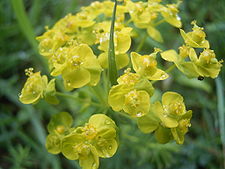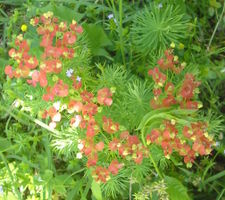
Cypress Spurge
Encyclopedia
Euphorbia cyparissias, the Cypress Spurge, is a plant in the genus Euphorbia, which is native to Europe
and was introduced to North America
in the 1860s by the colonists as an ornamental plant. It is sometimes called "Graveyard weed" as it is often seen in country graveyards.
In its natural setting, Cypress Spurge thrives in dunes, pannes, coastal headlands and grasslands; in North America it is commonly found in the dry, gravelly soil of roadsides, pastures, and meadows. Cypress Spurge thrives in open, disturbed areas rather than forests or highly cultivated soil.
It reproduces by seeds and also by the very well developed underground roots. It usually has a height of 10–80 cm (6-12 inches). Its petal
-like bract
s are usually green-yellow, maturing to purple or red from May to August. Cypress Spurge grows a fruit that, when mature, explodes to spread seeds up to 16 feet (4.9 m). However the plant also reproduces through lateral root buds which allows it to spread quick and densely. It can be easily identified by its leaves, which are small and linear (they have a length of 2–4 cm and a width of 1–2 mm).
When broken, cypress spurge, like all spurges, emits a milky sap. Other sources allege that the milky juice of the plant is toxic and causes irritations on contact with the skin. The sap may also irritate the eyes, mouth, and gastro-intestinal tract.
This plant is considered a noxious weed in many places, including the state of Colorado. Like most non-native plants, it infringes upon the growth of native species. The Spurge is known to be harmful to cattle and horses, but not sheep. The hardy Spurge can be difficult to control; several species of European insects were released in North America in this effort. Certain beetles and fleas have been found to be effective, but those may pose even more risk to native plants than the removal of the cypress spurge itself.


Europe
Europe is, by convention, one of the world's seven continents. Comprising the westernmost peninsula of Eurasia, Europe is generally 'divided' from Asia to its east by the watershed divides of the Ural and Caucasus Mountains, the Ural River, the Caspian and Black Seas, and the waterways connecting...
and was introduced to North America
North America
North America is a continent wholly within the Northern Hemisphere and almost wholly within the Western Hemisphere. It is also considered a northern subcontinent of the Americas...
in the 1860s by the colonists as an ornamental plant. It is sometimes called "Graveyard weed" as it is often seen in country graveyards.
In its natural setting, Cypress Spurge thrives in dunes, pannes, coastal headlands and grasslands; in North America it is commonly found in the dry, gravelly soil of roadsides, pastures, and meadows. Cypress Spurge thrives in open, disturbed areas rather than forests or highly cultivated soil.
It reproduces by seeds and also by the very well developed underground roots. It usually has a height of 10–80 cm (6-12 inches). Its petal
Petal
Petals are modified leaves that surround the reproductive parts of flowers. They often are brightly colored or unusually shaped to attract pollinators. Together, all of the petals of a flower are called a corolla. Petals are usually accompanied by another set of special leaves called sepals lying...
-like bract
Bract
In botany, a bract is a modified or specialized leaf, especially one associated with a reproductive structure such as a flower, inflorescence axis, or cone scale. Bracts are often different from foliage leaves. They may be smaller, larger, or of a different color, shape, or texture...
s are usually green-yellow, maturing to purple or red from May to August. Cypress Spurge grows a fruit that, when mature, explodes to spread seeds up to 16 feet (4.9 m). However the plant also reproduces through lateral root buds which allows it to spread quick and densely. It can be easily identified by its leaves, which are small and linear (they have a length of 2–4 cm and a width of 1–2 mm).
When broken, cypress spurge, like all spurges, emits a milky sap. Other sources allege that the milky juice of the plant is toxic and causes irritations on contact with the skin. The sap may also irritate the eyes, mouth, and gastro-intestinal tract.
This plant is considered a noxious weed in many places, including the state of Colorado. Like most non-native plants, it infringes upon the growth of native species. The Spurge is known to be harmful to cattle and horses, but not sheep. The hardy Spurge can be difficult to control; several species of European insects were released in North America in this effort. Certain beetles and fleas have been found to be effective, but those may pose even more risk to native plants than the removal of the cypress spurge itself.



